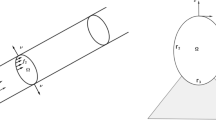Abstract
In this paper, we consider the elasticity problem based on the Hellinger–Reissner variational principle. We use the \(C^0\) continuous arbitrary degree polynomial mixed finite element spaces to approximate the stress and displacement, and develop a new stabilization method for the finite element space pairs to overcome the lack of the inf-sup condition, then we give the corresponding error estimates of the stabilization approximation scheme. At last, we implement a numerical example to test the stability and effectiveness of the proposed method.



Similar content being viewed by others
References
Arnold, D.N., Douglas, Jr, J., Gupta, C.P.: A family of higher order mixed finite element methods for plane elasticity. Numer. Math. 45, 1–22 (1984)
Morley, M.: A family of mixed finite elements for linear elasticity. Numer. Math. 55, 633–666 (1989)
Stenberg, R.: On the construction of optimal mixed finite element methods for the linear elasticity problem. Numer. Math. 48, 447–462 (1986)
Stenberg, R.: A family of mixed finite elements for the elasticity problem. Numer. Math. 53, 513–538 (1988)
Arnold, D.N., Winther, R.: Mixed finite element for elasticity. Numer. Math. 92, 401–419 (2002)
Arnold, D.N., Awanou, G.: Rectangular mixed finite elements for elasticity. Math. Models Methods Appl. Sci. 15(9), 1417–1429 (2005)
Adams, S., Cockburn, B.: A mixed finite elementmethod for elasticity in three dimensions. J. Sci. Comput. 25(3), 515–521 (2005)
Awanou, G.: Two remarks on rectangular mixed finite elements for elasticity. J. Sci. Comput. 50(1), 91–102 (2012)
Chen, S.C., Wang, Y.N.: Conforming rectangular mixed finite elements for elasticity. J. Sci. Comput. 47(1), 93–108 (2011)
Shi, D.Y., Li, M.H.: Superconvergence analysis of the stable conforming rectangular mixed finite elements for the linear elasticity problem. J. Comput. Math. 32(2), 205–214 (2014)
Arnold, D.N., Winther, R.: Nonconforming mixed elements for elasticity. Math. Models Methods Appl. Sci. 13(3), 295–307 (2003)
Gopalakrishnan, J., Guzmán, J.: Symmetric nonconforming mixed finite elements for linear elasticity. SIAM J. Numer. Anal. 49(4), 1504–1520 (2011)
Hu, J., Shi, Z.C.: Lower order rectangular nonconforming mixed elements for plane elasticity. SIAM J. Numer. Anal. 46(1), 88–102 (2007)
Man, H.Y., Hu, J., Shi, Z.C.: Lower order rectangular nonconforming mixed finite element for the threedimensional elasticity problem. Math. Models Methods Appl. Sci. 19(1), 51–65 (2009)
Yi, S.Y.: Nonconforming mixed finite element methods for linear elasticity using rectangular elements in two and three dimensions. Calcolo 42, 115–133 (2005)
Yi, S.Y.: A new nonconforming mixed finite element method for linear elasticity. Math. Models Methods Appl. Sci. 16(7), 979–999 (2006)
Carstensen, C., Eigel, M., Gedicke, J.: Computational competition of symmetric mixed FEM in linear elasticity. Comput. Methods Appl. Mech. Eng. 200, 2903–2915 (2011)
Carstensen, C., Günther, D., Reininghaus, J., Thiele, J.: The Arnold–Winther mixed FEM in linear elasticity. Part I: implementation and numerical verification. Comput. Methods Appl. Mech. Eng. 197, 3014–3023 (2008)
Hu, J., Man, H. Y., Zhang, S. Y.: The simplest mixed finite element method for linear elasticity in the symmetric formulation on n-rectangular grids. arXiv:1304.5428[math.NA] (2013)
Hu, J., Man, H.Y., Zhang, S.Y.: A simple conforming mixed finite element for linear elasticity on rectangular grids in any space dimension. J. Sci. Comput. 58(2), 367–379 (2014). doi:10.1007/s10915-013-9736-6
Franca, L., Farhat, C.: Bubble functions prompt unusual stabilized finite element methods. Comput. Methods Appl. Mech. Eng. 123, 299–308 (1995)
Brezzi, F., Douglas, J.: Stabilized mixed methods for the Stokes problem. Numer. Math. 53, 225–235 (1988)
Douglas, J., Wang, J.: An absolutely stabilized finite element method for the Stokes problem. Math. Comput. 52(186), 495–508 (1989)
Becker, R., Braack, M.: A finite element pressure gradient stabilization for the Stokes equations based on local projections. Calcolo 38, 173–199 (2001)
Matthies, G., Skrzypacz, P., Tobiska, L.: A unified convergence analysis for local projection stabilizations applied to the Oseen problem. M2AN Math. Model. Numer. Anal. 41(4), 713–742 (2007)
Bochev, P., Dohrmann, C.R., Gunzburger, M.: Stabilization of low-order finite elements for the Stokes equations. SIAM J. Numer. Anal. 44(1), 82–101 (2006)
Leborgne, G.: An optimally consistent stabilization of the inf-sup condition. Numer. Math. 91, 35–56 (2002)
Brezzi, F., Fortin, M.: A minimal stabilisation procedure for mixed finite element methods. Numer. Math. 89, 457–491 (2001)
Codina, R., Blasco, J.: A finite element formulation for the Stokes problem allowing equal velocity-pressure interpolation. Comput. Methods Appl. Mech. Eng. 143, 373–391 (1997)
Codina, R., Blasco, J.: Implementation of a stabilized finite element formulation for the incompressible Navier–Stokes equations based on a pressure gradient projection. Int. J. Numer. Meth. Fluids 37, 419–444 (2001)
Luo, Z.D.: Foundations and Applications of Mixed Finite Element Method. Science Press, Beijing (2006). (in Chinese)
Pehlivanov, A.I., Carey, G.F., Lazarov, R.D.: Least-squares mixed finite elements for second-order elliptic problems. SIAM J. Numer. Anal. 31(5), 1368–1377 (1994)
Franca, L.P., Stenberg, R.: Error analysis of Galerkin least squares methods for the elasticity equations. SIAM J. Numer. Anal. 28(6), 1680–1697 (1991)
Acknowledgments
This work was supported by NSFC 10971203 and NSFC 11271340.
Author information
Authors and Affiliations
Corresponding author
Rights and permissions
About this article
Cite this article
Shi, Dy., Li, Mh. & Xu, C. A New Stabilization Method for the Elasticity Problem. J Sci Comput 65, 1025–1038 (2015). https://doi.org/10.1007/s10915-015-9996-4
Received:
Revised:
Accepted:
Published:
Issue Date:
DOI: https://doi.org/10.1007/s10915-015-9996-4




